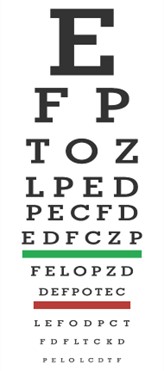A nurse is assessing the visual acuity of a client who wears glasses using a Snellen chart. Which of the following actions should the nurse take?
Position the client 3 meters (10 feet) away from the chart
Document the largest line the client can read on the chart
Instruct the client to begin the assessment with both eyes open
Begin by testing the client while they are wearing glasses
The Correct Answer is D
To test visual acuity using a Snellen chart, the nurse should have the patient wear glasses or contact lenses if they normally wear them . The patient should stand 20 feet from the chart . The nurse should tell the patient to first cover the right eye, then left eye, and lastly read the chart with both eyes .
The other options are not correct because:
a). The client should be positioned 20 feet away from the chart, not 3 meters (10 feet).
b) The nurse should document the smallest line the client can read accurately on the chart, not the largest line.
c) The nurse should instruct the client to begin the assessment by covering one eye and reading aloud the letters on the chart, beginning at the top and moving toward the bottom

Nursing Test Bank
Naxlex Comprehensive Predictor Exams
Related Questions
Correct Answer is A
Explanation
The nurse should identify that caring for a client who has a new onset of chest pain is outside the scope of practice for an LPN. This is a complex and potentially life-threatening situation that requires the assessment and intervention of a registered nurse (RN) or other advanced practice provider.
b) Caring for a client who has a tracheostomy is within the scope of practice for an LPN.
c) Caring for a client who is receiving enteral feedings is within the scope of practice for an LPN.
d) Caring for a client who has urinary retention is within the scope of practice for an LPN.
Correct Answer is C
Explanation
Answer: C. Weigh the client each morning after voiding
Rationale:
A. Encourage the client to gain 2.3 kg (5 lb) per week:
A weight gain goal of 0.5 to 1 kg (1 to 2 lb) per week is considered safe and realistic. Gaining 2.3 kg (5 lb) weekly is too aggressive and may cause physical and psychological stress for the client.
B. Monitor the client for 15 min after meals:
Clients with anorexia nervosa are at risk for purging behaviors. Monitoring for only 15 minutes is insufficient. A 60-minute post-meal observation period is more appropriate to deter vomiting or excessive exercise.
C. Weigh the client each morning after voiding:
Daily weights, taken at the same time each morning after voiding and before eating, provide consistent and accurate data to monitor progress and detect manipulation or fluid shifts.
D. Reinforce teaching about healthy eating during meals:
Reinforcing education during meals can increase the client’s anxiety and resistance to eating. Teaching is best done separately from mealtimes to avoid associating eating with stress.
Whether you are a student looking to ace your exams or a practicing nurse seeking to enhance your expertise , our nursing education contents will empower you with the confidence and competence to make a difference in the lives of patients and become a respected leader in the healthcare field.
Visit Naxlex, invest in your future and unlock endless possibilities with our unparalleled nursing education contents today
Report Wrong Answer on the Current Question
Do you disagree with the answer? If yes, what is your expected answer? Explain.
Kindly be descriptive with the issue you are facing.
